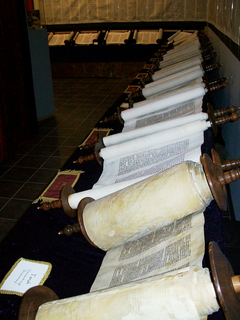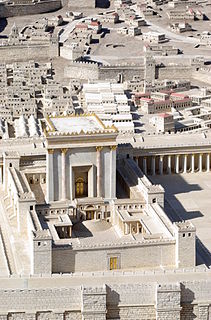The temple treasury was a storehouse (Hebrew אוצר 'otsar) first of the tabernacle then of the Jerusalem Temples mentioned in the Hebrew Bible. The term "storehouse" is generic, and also occurs later in accounts of life in Roman Palestine where the otzar was a tax-collector's grainhouse. [1]

According to the Tanakh the tabernacle was the portable dwelling (temple) of Yahweh (God) used by the children of Israel from the Exodus until the conquest of Canaan. It was constructed of woven layers of curtains and wood and richly furnished with valuable materials taken from Egypt. Moses was instructed at Mount Sinai to construct and transport the tabernacle with the Israelites on their journey through the wilderness and their subsequent conquest of the Promised Land. After 440 years, Solomon's Temple in Jerusalem superseded it as the dwelling-place of God.

The Hebrew Bible, also called the Tanakh or Mikra, is the canonical collection of Jewish texts, which is also the textual source for the Christian Old Testament. These texts are composed mainly in Biblical Hebrew, with some passages in Biblical Aramaic. The form of this text that is authoritative for Rabbinic Judaism is known as the Masoretic Text (MT), and is divided into 24 books, while the Protestant Bible translations divide the same material into 39 books.
The first mention of the "treasury of the LORD" occurs in Joshua 6:19 where all the silver and gold vessels are consecrated to a "storehouse" which travelled with the tabernacle. Later, this was made permanent in the First Temple, till the treasury was pillaged by Nebuchadnezzar's army. [2]

The Book of Joshua is the sixth book in the Hebrew Bible and the first book of the Deuteronomistic history, the story of Israel from the conquest of Canaan to the Babylonian exile. It tells of the campaigns of the Israelites in central, southern and northern Canaan, the destruction of their enemies, and the division of the land among the Twelve Tribes, framed by two set-piece speeches, the first by God commanding the conquest of the land, and, at the end, the last by Joshua warning of the need for faithful observance of the Law (torah) revealed to Moses.
In the Second Temple, the treasury was used for storing the grain for the Levites. In Nehemiah and Zechariah, this became the subject of contention when Eliashib, grandson of Joshua the high priest, leased the storehouse to Tobiah the Ammonite..

The Second Temple was the Jewish holy temple which stood on the Temple Mount in Jerusalem during the Second Temple period, between 516 BCE and 70 CE. According to Jewish tradition, it replaced Solomon's Temple, which was destroyed by the Neo-Babylonian Empire in 586 BCE, when Jerusalem was conquered and part of the population of the Kingdom of Judah was taken into exile to Babylon.

The Book of Zechariah, attributed to the Hebrew prophet Zechariah, is included in the Twelve Minor Prophets in the Hebrew Bible.
A related term, the korbanas, is found in the New Testament (Matthew 27:6) where the money of Judas Iscariot cannot be received into the temple "treasury", or κορβανᾶς korbanas, because it is "blood money". Josephus explains this term korbanas as the temple treasury - ton hieron thesauron, kaleitai de korbanas (War of the Jews 2.9.4; #175) [3] . Josephus says that Pontius Pilate used the korbanas to fund the construction of an aqueduct of about 400 stade, or 75 kilometers, and that this action incited the population to a riot [4] .

The New Testament is the second part of the Christian biblical canon, the first part being the Old Testament, based on the Hebrew Bible. The New Testament discusses the teachings and person of Jesus, as well as events in first-century Christianity. Christians regard both the Old and New Testaments together as sacred scripture. The New Testament has frequently accompanied the spread of Christianity around the world. It reflects and serves as a source for Christian theology and morality. Extended readings and phrases directly from the New Testament are incorporated into the various Christian liturgies. The New Testament has influenced religious, philosophical, and political movements in Christendom and left an indelible mark on literature, art, and music.

The Gospel According to Matthew is the first book of the New Testament and one of the three synoptic gospels. It tells how the promised Messiah, Jesus, rejected by Israel, finally sends the disciples to preach the gospel to the whole world. Most scholars believe it was composed between AD 80 and 90, with a range of possibility between AD 70 to 110. The anonymous author was probably a male Jew, standing on the margin between traditional and non-traditional Jewish values, and familiar with technical legal aspects of scripture being debated in his time. Writing in a polished Semitic "synagogue Greek", he drew on three main sources: the Gospel of Mark, the hypothetical collection of sayings known as the Q source, and material unique to his own community, called the M source or "Special Matthew".

Judas Iscariot(; Biblical Hebrew: יהודה, translit. Yehûdâh, lit. 'God is praised'; Greek: Ὶούδας Ὶσκαριώτης) was a disciple and one of the original Twelve Disciples of Jesus Christ. According to all four canonical gospels, Judas betrayed Jesus to the Sanhedrin in the Garden of Gethsemane by kissing him and addressing him as "Rabbi" to reveal his identity to the crowd who had come to arrest him. His name is often used synonymously with betrayal or treason. Judas's epithet Iscariot most likely means he came from the village of Kerioth, but this explanation is not universally accepted and many other possibilities have been suggested.
The treasury storehouse is to be distinguished from the hanuyot or "shops" near the Temple into which the Sanhedrin relocated from 30 to 70 CE.
The temple shops or Hebrew plural hanuyot (חנויות) were buildings near the Temple in Jerusalem mentioned in the Babylonian Talmud. According to the Talmud the Sanhedrin relocated to the temple shops, hanuyot, at some point before the destruction of the Temple in 70 CE. The plural hanuyot is also the word for "shops" in modern Hebrew.

The Sanhedrin were assemblies of either twenty-three or seventy-one rabbis appointed to sit as a tribunal in every city in the ancient Land of Israel.







